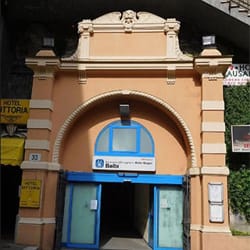Such revolution was needed to facilitate import trade of necessary foodstuffs for local consumption, in the export trade of the few surplus agricultural products of some types of manufactured goods from other regions.
Before the construction of the railways, transport was carried out in Liguria partially by road, on the back of a mule or with animal-drawn vehicles and sets out to sea with sailing vessels navigating along the coast of the two Rivieras.
The road network was made up of national, provincial and municipal roads as it is today.
Back then, the wider and longer national roads were intended for communications with foreign countries and to facilitate the large-scale maritime trade and military defense.
The provincial roads generally connected the provincial capitals to each other and connected with the national roads.
The municipal roads connected the municipalities to the small villages.
In the mid-nineteenth century, passenger transport took place on postal coaches and stagecoaches in service between Genoa and the main locations of the Riviera and the hinterland.
To go from Genoa to Turin it took about one day and travel times for goods transport were even longer, considering the weight of the loads: up to one week to Turin from Genoa.
The duration of the journey was linked to roads in fair condition and expeditions carried out in good weather too…
Due to the morphology, geographical position and shape of Liguria, the roads could and can be along the coast towards France and Tuscany and along the meridians towards Piedmont, Lombardy and Emilia.

Liguria transportation system
The first ones served local communications and they were useful to link Mediterranean France with Tuscany.
The second served to connect the coast of the two Rivieras with the interior of the Po Valley and found their implementation via the mountain passes existing along the Southern Maritime Alps and those of the Ligurian Apennines.
According to these natural directions, the various railway lines that gave rise to development were built at different times in Liguria and significantly influenced the territorial structures and social and economic conditions of the region.
The cost of rail transport was much lower than both road and sea transport, as was the duration
of the journey was considerably shorter, since it was possible to go by rail from Genoa to Turin in under 7 hours.
Consequently, shipments of goods became more frequent and regular and transport could be carried out even under conditions unfavorable weather conditions, without increasing the price.
When the opening of a new section of railway was announced, the services were no longer even mentioned of stagecoaches, cars and carts along the same route.
Unfortunately, the choice of building the railway tracks only along the coast and behind the cities of Savona, Genoa and La Spezia alone, left large areas of Liguria interiors without this new means of transport, just as they are today.
The railway facilitated the movement of goods and people, but the high costs for the construction of the various railways delayed for many years the construction of an efficient and complete system of local carriage roads in Liguria. This delay caused incalculable damage to the internal areas not crossed by the railway which found themselves without service and, at the same time, also poorly served by carriage roads. As a consequence, such areas underwent a slower and more difficult economic and social development compared to the other Ligurian territories “touched” by the railway and still today these villages have virtually no infrastructure and suffer from a lack of tourism, jobs and therefore they are becoming ghost towns.






























































